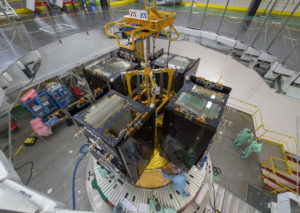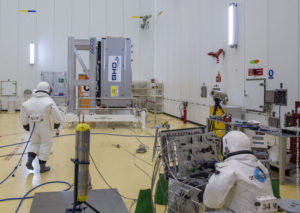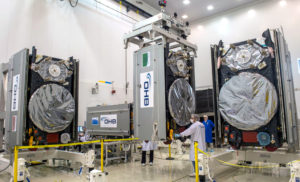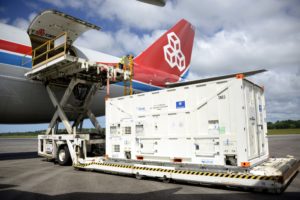
Today Europe’s next four Galileo satellites will be launched into orbit by Ariane 5 from Europe’s Spaceport in French Guiana. With this launch the Galileo constellation will reach 26 satellites in space, completing the constellation in overall numbers although further launches are needed to place back-up satellites in orbit. The launch comes at a time when Galileo is into its second year of Initial Operations, with a signal that is better than expected and that is now usable in all new mobile phones. This video looks at Galileo’s story so far and the way forward, interviewing Paul Verhoef, ESA Director of Navigation, and Valter Alpe, Galileo’s Satellite Production and Launch Campaign Manager.
Since the launch of the ‘Galileo In-Orbit Validation Element’ Read more…
For its fourth launch of the year, Arianespace will orbit four more satellites (satellites 23 to 26) for the Galileo constellation. This mission is being performed on behalf of the European Commission under a contract with the European Space Agency (ESA).
For the third time, an Ariane 5 ES version will be used to orbit satellites in Europe’s own satellite navigation system; with all Galileo spacecraft having been launched to date by Arianespace. Ariane 6 will take over from 2020. Read more…
Europe’s next Galileo satellites have been put in place on top of the Ariane 5 launcher due to lift them from Europe’s Spaceport in Kourou, French Guiana on Wednesday 25 July.

Galileo satellites 23-26 were lifted to the top of their Ariane 5 launcher inside the BAF ‘Bâtiment d’Assemblage’ building on Wednesday 11 July, ahead of their Wednesday 25 July 2018 launch.
The launcher – appearing headless in the absence of its final payload – was moved from the BIL Launcher Integration Building, where it was assembled, to the BAF Final Assembly Building, ready for the Galileo satellites to be mated with it. Read more…
Europe’s next four Galileo satellites have been fuelled at Europe’s Spaceport in Kourou, French Guiana, in preparation for their launch on 25 July.

Technicians on SCAPE (Self Contained Atmospheric Protection Ensemble) suits to fill Galileo satellites 23-26 with hydrazine fuel. This operation took place in the Guiana Space Centre’s S3B payload preparation building on 29 June 2018
The four satellites were placed into their protective containers to be transported from the S1A processing building to the S3B payload preparation building, where they were filled with the hydrazine fuel that will keep the satellites manoeuverable during their 12-year working lives. Read more…
The four Galileo satellites for Arianespace’s next Ariane 5 mission at the service of Europe’s navigation system are coming together in their flight configuration, while parallel preparations continue with the mission’s heavy-lift launcher.

In the Spaceport’s S1A clean room facility, the four Galileo FOC satellites are prepared for their fit-check evaluation with the mission’s payload dispenser
During pre-flight activity in French Guiana at the Spaceport’s S1A processing facility, these FOC (Full Operational Capability) spacecraft have undergone their fit-checks with the dispenser system to be installed on Ariane 5. Read more…
Galileo satellites 25 and 26 have landed at Europe’s Spaceport in Kourou, French Guiana, joining their two predecessors ahead of their 25 July launch by Ariane 5.

One of the two Galileo satellites 25 and 26 being unloaded from their Boeing 747 cargo jet at Cayenne – Félix Eboué Airport in French Guiana on 1 June 2018. The satellites travel inside protective air-conditioned containers.
The pair left Luxembourg Airport on a Boeing 747 cargo jet on the morning of 1 June, arriving at Cayenne – Félix Eboué Airport in French Guiana that evening. Read more…